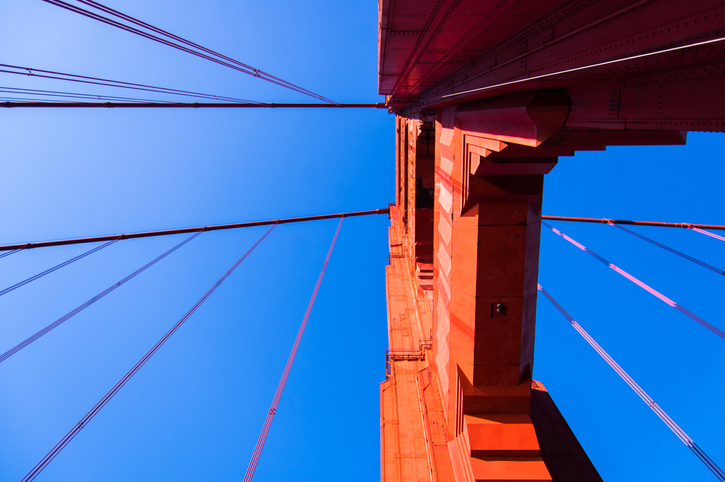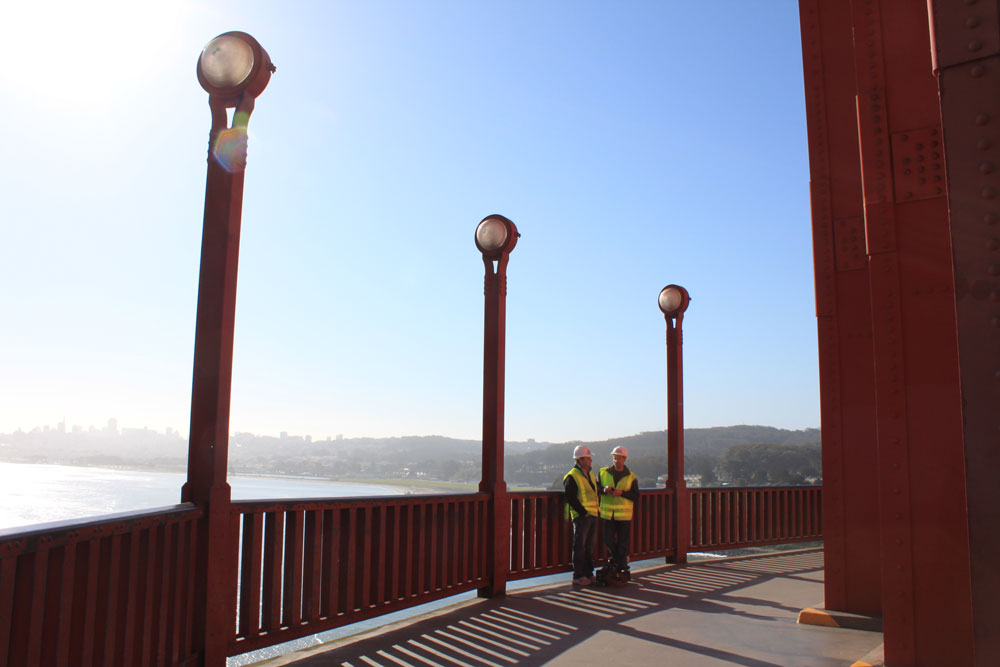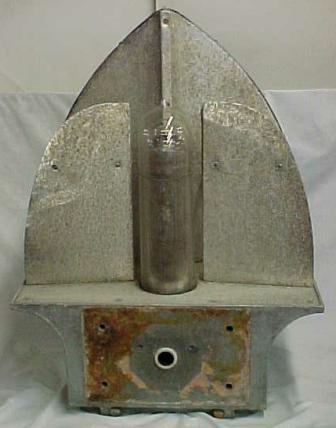Color - International Orange

When the steel for the Golden Gate Bridge was fabricated by Bethlehem Steel at its foundries in Pennsylvania and New Jersey, the steel was coated with a red lead primer. As the bridge towers began to rise for the Golden Gate Bridge, consulting architect Irving F. Morrow was commuting to the construction site from his home in the East Bay via ferry. He became inspired by the red lead color. Morrow undertook color studies, which resulted in the specification of the unique Golden Gate Bridge International Orange because it blended well with the nearby hills and contrasted with the ocean and sky.
Morrow recognized very clearly that the Bridge color was a very important influence on its appearance in relationship to its surroundings. As the Bridge stands today, the color blends perfectly with the changing season tints of the spans’ natural setting against the San Francisco skyline and the Marin hills. Morrow concluded, “The effect of International Orange is as highly pleasing as it is unusual in the realm of engineering.”
The color dubbed “International Orange” existed before the Bridge (and still exists) and is a color used in the aerospace industry to set things apart from their surroundings, similar to safety orange, but deeper and with a more reddish tone. You can see this, the “other” International Orange color here: http://en.wikipedia.org/wiki/International_orange. The Golden Gate Bridge is painted Golden Gate Bridge International Orange which was selected by Consulting Architect Irving F. Morrow.
In his April 1935 Report on Color and Lighting, Morrow defined the approach to the color section, “Preliminary to discussion of particular colors, a decision must be made on a matter of policy – is it desired to emphasize the bridge as an important feature of the landscape, or to make it as inconspicuous as possible.”
The final color was inspired by studies undertaken by Morrow in cooperation with other architects, engineers, painters, sculptors, and others. Morrow also included black, grey, and aluminum in the studies, ruling each out for a range of reasons. Black would be unattractive and would reduce the scale of the bridge more than any other color. Proponents for the aluminum color reported that this color would give beauty as the beauty of a dirigible aircraft. Morrow rejected it as the towers would be deprived of substance and made tiny. Battleship grey and warm grey were studied. Warm grey was named as the distant second to orange vermillion.
Italian American sculptor Beniamino Benvenuto Bufano submitted his comments to Morrow, “ I have been watching very closely the progress of the towers on the Golden Gate Bridge in its structural beauty its engineering and architectural simplicity – and of course its color that moves and molds itself into the great beauty and contours of the hill – let me hope that the color will remain the red terracotta because it adds to the structural grace and because it adds to the great beauty and the colorful symphony of the hills—and it is because of this structural simplicity that carries to you my message of admiration.”
Listen to Kevin Starr talk about Golden Gate Bridge Consulting Architect Irving Morrow’s selection of the International Orange color: www.aol.com/video/view/the-history-of-the-color-of-the-golden-gate-bridge/517407970/.
Color Formula
The Golden Gate Bridge International Orange color is mixed to our requirements. The Bridge has maintained our formula for GGB International Orange through the years. Our requirements are in no way proprietary, anyone can formulate and use the color – in fact we provide the color percentages on the website. What passes for International Orange is going to vary by manufacturer or standard of which there are many. When purchasing paint for the Golden Gate Bridge, it is done through a competitive bidding process. Currently, the paint is supplied by Sherwin Williams and is made to match the GGB International Orange color formula. For compliance purposes we use ASTM D 2244 – Standard Practice for Calculation of Color Tolerances and Color Differences from Instrumentally Measured Color Coordinates.
When purchasing paint for the Golden Gate Bridge, it is done through a competitive bidding process. Currently, the paint is supplied by Sherwin Williams and is made to match the Bridge International Orange color formula. The closest off-the-shelf paint color that Sherwin Williams has available is "Fireweed" (color code SW 6328).
Many people ask about the formula for the Bridge’s unique International Orange paint color. Paint stores can mix it with the following information:
CMYK colors are: C= Cyan: 0%, M =Magenta: 69%, Y =Yellow: 100%, K = Black: 6%.
The closest existing color codes to GGB International Orange color are:
PMS 173 (CYMK = 0%, 80%, 94%, 1%),
PMS 174 (CYMK 8%, 85%, 100%, 34%)
Pantone 180 (CYMK 19.4%, 77.9%, 79.6%, 3.6%)
Art Deco Design Theme

The original plans submitted by Chief Engineer, Joseph B. Strauss, called for a hybrid cantilever and suspension structure across the Golden Gate. This plan was generally regarded as unsightly, and a far cry from the elegant, understated lines that define the Bridge today. After Strauss submitted his first design, Consulting Engineer, Leon S. Moisseiff, theorized that a long span suspension bridge could cross the Gate. A suspension structure of this length had never been tried before.
Even after Moisseiff and Strauss began to refine the new design, it wasn't until Consulting Architect Irving F. Morrow joined the project that the art deco styling began to take shape. Morrow simplified the pedestrian railings to modest, uniform posts placed far enough apart to allow motorists an unobstructed view. The light posts took on a lean, angled form. Wide, vertical ribbing was added on the horizontal tower bracing to accent the sun's light on the structure. The rectangular tower portals themselves decrease on ascent, further emphasizing the tower height. These architectural enhancements define the Golden Gate Bridge's art deco form. It is this form which is known and admired the world over.
Visit our Photo Gallery to see various Art Deco elements at the Bridge, and read more about the Art Deco style and movement.
Bridge Lighting

Consulting Architect, Irving F. Morrow, wrote Report on Color and Lighting to Chief Engineer, Joseph B. Strauss, on April 6, 1935. In his report, he indicated that the two most important factors in lighting the Golden Gate Bridge were the enormous size of the project and the tremendous scale and dignity of the project. Morrow carefully weighed these considerations as he designed his lighting scheme, one which would even further accent the uniqueness of the Golden Gate Bridge.
Because of the Bridge's great size, Morrow did not want the same intensity of light on all of its parts. The effect would seem too artificial. The towers, for example, were to have less light at the top, so they would seem to soar beyond the range of illumination. Further, because of the scale and dignity of the Bridge, Morrow believed tricky, flashy or spectacular lighting would be unworthy of the structure's magnificence. Thus, he selected low pressure sodium vapor lamps with a subtle amber glow for the roadway, providing warm, non-glare lighting for passing motorists. The lamps were the most modern available in 1937.
Forty-five years later in 1972, the original low pressure sodium roadway lights were replaced with high-pressure sodium vapor lamps. These modern lamps provide improved lighting at a lower cost. To preserve the original warm glow, the new lampheads have a plastic amber lens.
The tower lighting, as originally envisioned by Morrow, was not installed during the construction of the Bridge due to budgetary constraints. However, in 1987, shortly after the 50th Anniversary, the Bridge towers came to life with light on June 22, 1987. Just as Morrow had envisioned, the new lighting made the towers seem to disappear into the evening darkness, further accenting their great height. The tower lighting was installed at a cost of nearly $1.2 million, funded in part, through a generous grant from Pacific Gas & Electric Company. The lighting was installed by Abbett Electric Company, who under-bid the original construction estimates by nearly $1 million.
- Main Cable Lights: There are eight 116 watt lights on each of the two main cables.
- Roadway Lights: There are 128 lamp posts that line the roadway. In 1972, the original low pressure sodium (LPS) lighting (90 watts each) within the lamp posts were changed to high pressure sodium (HPS) lighting (227 volt and 250 watt each). (See photo of original light below)
- Tower Sidewalk Lights: There are a total of 24 sidewalk-level lights with six at each of the four tower legs. They were installed in 1938 and are LPS lights, 35 watts each. The light Globe is a Holophane #1611 Globe, 15 15/16”w x 7 ¾” diameter. In 1984, the Bridge electric shop replaced the no-longer-manufactured globes with plastic replacement globes from Glenn Plastics, Riverbank, CA.
- Tower Decorative Lighting: These are HPS, 400 watt decorative floodlights; with 12 at the sidewalk level pointed upward on each tower. There are also 12 HPS lights below the roadway for each tower; four are 150 watts, four are 250 watts, and four are 400 watts.
- Aircraft Beacons: Installed in 1980, each tower now has a 360 degree flashing red aircraft beacon at the very top of the tower. Each beacon has two 750 watt lamps.Originally, the aircraft beacons had a single rotating red light; with a built-in “back-up” light.
- Navigation Beacons: The San Francisco tower pier has one 1,000 watt beacon facing northward, with four 116 watt lights on the tower fender. The Marin tower pier has three 116 watt lights on three sides facing the water.
- Midspan Navigation Lighting: For seafaring vessels, there are eight lights that mark the center of the Bridge below the deck at midspan; four on each side in a vertical column. The top three lights are white, the bottom light green.
Original Lighting with the Roadway Lamp Post
